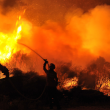Special report: Disinfecting local government facilities to combat COVID-19
Local governments are working to keep citizens and employees safe from the COVID-19 pandemic through effective and widespread disinfection. It’s a big job. Cities, counties and other local governments own a total of 558,000 buildings, which is almost 10 percent of the nation’s 5.6 million commercial-nonresidential structures, says the latest “Commercial Buildings Energy Consumption Survey” (CBECS) from the U.S. Energy Information Administration (EIA). This posting has more information on the CBECS survey and number of local government buildings.
Governments will continue to be major purchasers of cleaning and disinfecting chemicals, says Cleveland-based market researcher The Freedonia Group. Annual value of government purchases of these chemicals will rise from $335 million in 2017 to $390 million in 2022, says Freedonia report #3646. The compound annual growth rate for government purchases of these chemicals from 2017 to 2022 will reach 3.1 percent, according to Freedonia estimates.
Freedonia forecasters also predict steady sales growth for disinfecting wipes to government. Value of purchases of wipes used in government, commercial and institutional settings is projected to increase 2.3 percent per year to $178 million in 2023. One reason governments will be buying more wipes, according to Freedonia analysts: Continued concern over the threat of bioterrorism in government settings, which will encourage the use of disinfectant wipes. The data is from Freedonia market report #3722.
As government and other facilities start to reopen following the COVID-19 pandemic, it’s important that facility managers have a plan, says Sean McCrady, National Service Line Manager, Indoor Environmental Quality, at UL. McCrady says the plan for reopening should include three stages:
Stage 1: Think
Stage 2: Plan
Stage 3: Verify
Facility directors need to think and focus on measures to safeguard occupants from the virus so they can safely reoccupy a building that’s been vacant for a short term, McCrady says. He adds that it is important that directors develop an actions checklist that covers virus prevention through disinfection, implementing new defense systems against germs and other activities that often are addressed through ongoing building maintenance.
In the planning stage, facility managers rely on their actions checklist to help them get the building and its occupants prepared for re-entry. In this stage, managers need to determine if new or additional rules are warranted for building operations or cleaning procedures.
In the verify stage, McCrady says managers will locate and access yardsticks that measure cleaning effectiveness, virus tracking and suppression. The verification tools will also enable discovery and mitigation of unintended consequences.
It’s crucial in the reopening process that custodians and janitors get up-to-date instruction on disinfecting and cleaning processes, McCrady explains. Facility directors, he adds, should consult training resources and blood-borne pathogen training guidelines from the Centers for Disease Control and Prevention (CDC) and the Occupational Safety and Health Administration (OHSA). If facility cleaning is contracted out, contractors should be briefed on proper cleansing techniques and procedures, McCrady says.
Because HVAC systems are essential to maintaining indoor air quality, air exchange and airflow, McCrady says HVAC system settings and performance should be reviewed as part of a building reopening. Building operators may want to boost air filtration post-COVID-19, McCrady explains, but factors such as increased heating-cooling expenses or greater carbon discharges may need to be weighed. This NATE Magazine issue outlines COVID-19 as it relates to HVAC.
Local Governments’ Preparation Plans for COVID-19
An appropriate COVID-19 disinfecting plan will include a disease prevention strategy, believes Craig Sturak, Communications Officer at San Diego County’s (Calif.) Health & Human Services Agency. Sturak says a well-executed plan “aids not only in slowing the spread of COVID-19, but also helps protect both the employees and the public doing business with the agency by reducing the risk of exposure to COVID-19.”
Sturak says it’s crucial to include the following in a COVID-19 disinfecting plan:
- Show consideration and understanding about the safety of the staffers who will be disinfecting the workplace,
- Ensure that the right disinfecting products are used and that the right disinfection method for each product is applied, and
- Include periodic reviews to update the plan every time new guidance or operational changes are introduced.
It’s important and appropriate for a public agency to have a COVID-19 disinfecting plan, believes Wade Balmer, who is Public Information Officer at the Department of General Services at the City and County of Denver, Colo. “Custodial teams within public agencies have a responsibility to ensure a high level of customer service as employees return to work by preventing COVID-19 transmission among employees, preserving effective business operations, and maintaining a healthy work environment.” Balmer adds that as a bonus, developing and sharing a disinfecting services plan will help to alleviate anxiety and concerns among building occupants.
Denver’s Department of General Services has both internal custodial teams that are employed by the city as well as an ongoing contract for custodial services with an outside contractor. Both groups provide cleaning and disinfecting services to the 131 facilities within the department’s portfolio.
Balmer spotlights the following as essential pieces in a public agency’s disinfecting plan:
–Base your plan on established public health and industry resources and science,
–Ensure that stakeholders are aware of the resources and internal and external parties that the agency has involved in the plan, and
–Include information about any new disinfecting technologies used, application frequency and the process for how disinfecting services can be requested.
Balmer says it is critical that the plan be designed so it can change and evolve. “COVID-19 information has been changing quickly, especially related to transmission. Be ready for your agency plan to be nimble and to be able to change in a short amount of time. Plan for ways to communicate changes to your team members and stakeholders so that they have the latest information.”
Susan Brown, Facilities Management Director for Coconino County, Ariz. (2019 population: 143,476), believes it is important for a public agency to have a COVID-19 disinfecting plan. “The plan should be transparent and reflect the guidance it follows, such as the CDC, OSHA and the local health authority. The plan should be available for employees and the public to review should they want or need to do so.” Coconino County is the second largest county in geographic area in the U.S. with 18,661 square miles. The county regularly disinfects about 35 buildings within the jurisdiction.
Brown adds that the basics of the plan are critical. “These can include: when will disinfection be done, what methods of disinfection will be used, what disinfectants will be used, how often disinfection will be repeated and what personal protective equipment (PPE) will be worn.”
Yes, efforts to reopen following sheltering-in-place should include comprehensive planning, says Steve Bennett, Senior Vice President, Scientific & Regulatory Affairs at the Household and Commercial Products Association (HCPA). The group represents manufacturers of cleaning, disinfecting and maintenance products used in the home and commercial environments.
“In addition to wearing face masks and implementing social distancing requirements, reopening efforts must include rigorous plans and protocols for cleaning and disinfecting public spaces, including city and county buildings,” Bennett says. He notes that government facilities have a dual role as they consider reopening:
(1) Can their workers be protected while providing services to the public? and
(2) Can the public be protected while receiving those services?
“There is no one-size-fits-all standard for cleaning,” Bennett explains. “It will depend on the type of space, its location, the amount of traffic the facility gets, and the types of materials that need to be disinfected.”
Cleansing Programs Vary Based on the Type of Public Facility
The frequency of disinfecting in local government facilities can vary; it can depend on the number of public visitors and government employees in the building, says Coconino County’s Susan Brown.
“Some facilities do not have a public interface, so their frequency of disinfection is once or twice per day, unless the building is only visited and not staffed. Those facilities are disinfected only as needed. Others, that are high-traffic with both public and employees, will get disinfected up to four times per day. Otherwise, the supplies and equipment we use are standard across all facilities,” Brown says.
Areas where there are high concentrations of people—-both public and staff–require disinfecting be done more frequently, Brown says. “Public transaction areas, public bathrooms, stairwells, waiting areas, elevators and any other areas where people must linger and touch surfaces–those areas need to be cleansed more completely.” Brown adds that the county dedicates a greater number of staff hours to disinfecting its courts buildings. “They often have more in-person, public transactions and activity than most other county facilities. The nature of their mission requires so many of their services to be done face-to-face, so more citizens come and go from the facilities and more staffers are providing those services in-person,” Brown explains.
Brown points out that Coconino County is both small and rural, so no facility has dedicated cleaning staff. “Our crews work shifts that go around the clock and move from building to building throughout the day and night to effectively cover everywhere.” She notes that the first shift starts at 4:00 a.m. and the final shift ends at 2:30 a.m., so only about 90 minutes of a day passes without cleaning.
Denver City and County’s Wade Balmer believes different kinds of public facilities and surfaces require different cleansing routines. “The cleaning and disinfecting services’ frequency can vary based on the density of occupancy or frequency of use of a facility. Our facilities that are operational 24/7 have more frequent cleanings and disinfecting services. Certain facilities may have much more high-touch areas that need to be addressed, such as courts, where members of the public and employees interact with many more services and move about the buildings more frequently.”
Brown says her Coconino County facilities team is constantly collaborating to develop new protocols and refine the ones it already has. “Our staff has a vast and skilled understanding of their job, so we constantly work together to get their input and advice on the best ways to effectively disinfect surfaces. They have extensive knowledge of best practices from good application techniques, to seasoned understanding of ‘kill times’ for chemicals on virus, to where the most problematic and dirty surfaces may be.”
Cleaning crews are knowledgeable, and they should be consulted, Brown believes. “Those that do cleaning and disinfecting every day understand a lot about human behavior; use that knowledge to anticipate how humans interact and how they occupy and use space.” Observe your sanitizing teams carefully, she adds. “Watch what they do and how they do it and adapt your disinfection protocols to make sure you are disinfecting where and how people actually use the building.”
UL’s Sean McCrady sums up what is most important to include in a cleaning-disinfecting plan for a public agency: “Ensure that the janitorial processes are up to date, with specific focus on cleaning frequency, choosing the right cleaning/disinfecting products, and training for janitorial staff according to guidance from organizations like OHSA and the CDC. Always read and follow the directions on the label,and use appropriate PPE.”
Michael Keating is an editor-at-large for American City & County. You can contact him at [email protected]
This report is brought to you by Cartegraph and Ovvi.






















